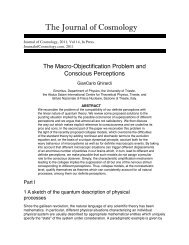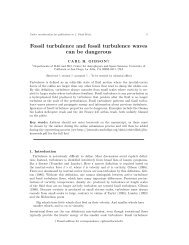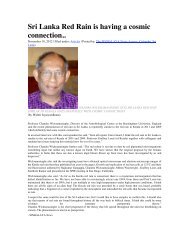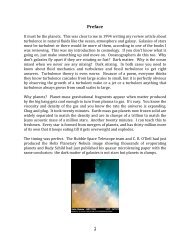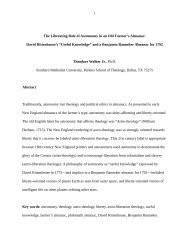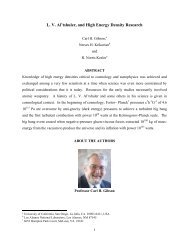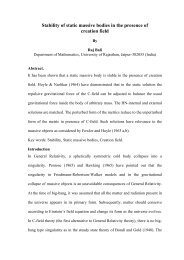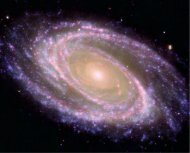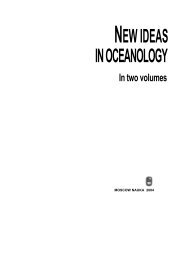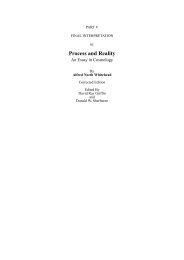Journal of Cosmology Editor-in-Chief Rudy Schild
Journal of Cosmology Editor-in-Chief Rudy Schild
Journal of Cosmology Editor-in-Chief Rudy Schild
Create successful ePaper yourself
Turn your PDF publications into a flip-book with our unique Google optimized e-Paper software.
<strong>Journal</strong> <strong>of</strong> <strong>Cosmology</strong>, 2013, 22, 10024-‐10041<br />
Commentary for <strong>Journal</strong> <strong>of</strong> <strong>Cosmology</strong> Volume 22<br />
<strong>Rudy</strong> <strong>Schild</strong> (Harvard-Smithsonian Center for Astrophysics)<br />
<strong>Editor</strong>-<strong>in</strong>-chief, <strong>Journal</strong> <strong>of</strong> <strong>Cosmology</strong><br />
Polonnaruwa4 - Yes, Diatoms Have Been Found <strong>in</strong> the Polonnaruwa<br />
Meteorite<br />
This commentary on the recent publication <strong>of</strong> evidence <strong>of</strong> formerly and presently liv<strong>in</strong>g<br />
species <strong>in</strong> a cometary meteorite was met with skepticism, but further research has<br />
corroborated all <strong>of</strong> the <strong>in</strong>itial claims. However some <strong>of</strong> the most recent criticism has<br />
been wholly unjustified, and the follow<strong>in</strong>g is a specific response to the critical review<br />
published on March 12, 2013 follow<strong>in</strong>g two papers published front-to-back <strong>in</strong> <strong>Journal</strong> <strong>of</strong><br />
<strong>Cosmology</strong> on 4 and 5 March 2013 (Wickramas<strong>in</strong>ghe et al 2013e and Wallis et al 2013).<br />
In the commentary to follow, we follow the organization and <strong>in</strong> particular the section<br />
head<strong>in</strong>gs <strong>of</strong> the most outrageous misrepresentation <strong>of</strong> scientific facts on the commercial<br />
blog site which is ma<strong>in</strong>ta<strong>in</strong>ed by Bad Astronomer Phil Plait (PP).<br />
1. Introduction<br />
The 5 <strong>in</strong>troductory paragraphs state the overall science issues raised by discovery that life<br />
forms, both liv<strong>in</strong>g and ext<strong>in</strong>ct, are seen both liv<strong>in</strong>g and fossilized <strong>in</strong>to ancient meteorite<br />
material. He then summarizes these reports, based upon <strong>in</strong>accurate citation and with<br />
bogus arguments, <strong>of</strong>ten ignor<strong>in</strong>g critical science laboratory results and procedures, “It’s<br />
wrong. Really really wrong. Way, way, way ridiculously oh-holy-wow-how-couldanyone-publish-this<br />
wrong.”<br />
2. That’s the J <strong>of</strong> C<br />
Here the blog seeks to defame the character and career <strong>of</strong> Pr<strong>of</strong>essor Chandra<br />
Wickramas<strong>in</strong>ghe, who is the found<strong>in</strong>g director <strong>of</strong> the world’s oldest astrobiology <strong>in</strong>stitute<br />
at Cardiff University and also a Pr<strong>of</strong>essor and Director <strong>of</strong> the Buck<strong>in</strong>gham Center for<br />
Astrobiology at Buck<strong>in</strong>gham University. Here PP uses ad hom<strong>in</strong>um arguments<br />
compar<strong>in</strong>g a dist<strong>in</strong>guished university pr<strong>of</strong>essor and researcher, who has made paradigmshift<strong>in</strong>g<br />
contributions to the astrophysics <strong>of</strong> <strong>in</strong>terstellar dust, to Sylvia Brown and Jenny<br />
McCarthy. Along the way he portrays Pr<strong>of</strong>essor Wickramas<strong>in</strong>ghe as a fanatic proponent<br />
<strong>of</strong> life beyond our planet’s surface. In fact, the weight <strong>of</strong> evidence is now tipp<strong>in</strong>g <strong>in</strong><br />
favor <strong>of</strong> abundant <strong>of</strong>f-planet life, and perhaps cont<strong>in</strong>u<strong>in</strong>g developments with<strong>in</strong> science<br />
will justify such enthusiasm.<br />
It should be mentioned <strong>in</strong> pass<strong>in</strong>g that Pr<strong>of</strong>essor Wickramas<strong>in</strong>ghe holds the highest<br />
science degree <strong>of</strong> the University <strong>of</strong> Cambridge (ScD), was formerly a Fellow <strong>of</strong> Jesus<br />
College <strong>of</strong> that ancient University and holds honorary doctorates from universities
<strong>Journal</strong> <strong>of</strong> <strong>Cosmology</strong>, 2013, 22, 10024-‐10041<br />
worldwide. He has over 300 papers <strong>in</strong> so-called “peer-reviewed” journals, some 70 <strong>of</strong><br />
which are <strong>in</strong> the journal Nature.<br />
At this po<strong>in</strong>t, we note that Pr<strong>of</strong>essor Wickramas<strong>in</strong>ghe, maliciously labeled a fr<strong>in</strong>ge<br />
scientist by PP, is jo<strong>in</strong>ed <strong>in</strong> authorship by 12 additional scholars, and perhaps it is time to<br />
take notice <strong>of</strong> their conclusions.<br />
Then PP seeks to impugn the <strong>Journal</strong> <strong>of</strong> <strong>Cosmology</strong>. Probably all journals have<br />
published at least one article that is regrettable, and it is still probable that Tyche is <strong>in</strong><br />
fact a rogue planet; I would rem<strong>in</strong>d that most theoreticians today will admit privately,<br />
though not publicly, that 90% <strong>of</strong> what they publish <strong>in</strong> The Astrophysical <strong>Journal</strong> is<br />
wrong. And the private comments <strong>of</strong> an editor no longer associated with <strong>Journal</strong> <strong>of</strong><br />
<strong>Cosmology</strong> are irrelevant.<br />
(Note: It is now well documented that Tyche is <strong>in</strong> fact a 3-Jupiter mass object at the Oort<br />
cavity boundary 3x10^15 meters from Earth, CHG)<br />
3. Diatomaceous Earth<br />
We do not comment on this section, which describes the reaction <strong>of</strong> Dr. Patrick Kociolek<br />
to only the photographs <strong>in</strong> Wickramas<strong>in</strong>ghe et al (2012d)<br />
and not to the technical laboratory analysis reported previously <strong>in</strong> Wallis et al<br />
(2013). It was unfair and prejudicial <strong>of</strong> PP to ask Dr. Kociolek to comment on a s<strong>in</strong>gle<br />
manuscript without the support<strong>in</strong>g documents.<br />
It would be fair to say that Dr. Kociolek would probably have moderated his remarks had<br />
he known <strong>of</strong> the extensive laboratory work reported <strong>in</strong> Wallis et al (2013) that shows<br />
from chemical and structural analysis that some <strong>of</strong> the diatoms are <strong>in</strong>deed fossilized and<br />
therefore not understood as post-fall contam<strong>in</strong>ants.<br />
And Dr. Kociolek does not comment on the other life forms seen <strong>in</strong> the proven cometary<br />
meteoritic material (Wallis et al, 2013, Fig. 6)<br />
4. Meteorwrong<br />
Here we f<strong>in</strong>d six seem<strong>in</strong>gly relevant questions. But <strong>in</strong> fact the six questions have been<br />
fully answered <strong>in</strong> the two companion papers published 10 days before the criticism<br />
(Wallis et al, 2013; Wickramas<strong>in</strong>ghe et al, 2013e).<br />
Some <strong>of</strong> the answers are complex, and we copy the answers with quotations from the<br />
published scientific reports.<br />
Q1 Exactly where was the meteor found?
<strong>Journal</strong> <strong>of</strong> <strong>Cosmology</strong>, 2013, 22, 10024-‐10041<br />
A1. The question conta<strong>in</strong>s the assumption that the meteorite was found <strong>in</strong>tact <strong>in</strong> a s<strong>in</strong>gle<br />
location. But as reported <strong>in</strong> Wallis et al (2013) “the meteor exploded and showered the<br />
area with hot explosion fragments. Thus PP is forc<strong>in</strong>g upon us his assumptions that are at<br />
variance with scholarly report<strong>in</strong>g. The fact that the meteor “dis<strong>in</strong>tegrated <strong>in</strong>to sparkl<strong>in</strong>g<br />
fragments” (Wallis et al 2013) makes credible that many fragments would be found, and<br />
if Dr. Kociolek or PP were to ask the authors, they would probably be sent a fragment if<br />
the request<strong>in</strong>g party could demonstrate an ability to conduct sterile analysis with useful<br />
<strong>in</strong>struments such as those already applied.<br />
The clear identification <strong>of</strong> many fragments as meteoritic is also clearly stated <strong>in</strong> Wallis et<br />
al 2013); “a distribution <strong>of</strong> stones [was] recovered from a strewn field <strong>of</strong> >10 km. Police<br />
records <strong>in</strong>dicate reports <strong>of</strong> low level burn <strong>in</strong>juries from immediate contact with the fallen<br />
stones and subsequent reports <strong>of</strong> a strong aroma. One woman was reported to have lost<br />
consciousness and was transported to the hospital after <strong>in</strong>hal<strong>in</strong>g fumes from one <strong>of</strong> the<br />
stones. Witnesses reported that the newly fallen stones had a strong odour <strong>of</strong> tar or<br />
asphalt. Local police <strong>of</strong>ficials responded immediately by collect<strong>in</strong>g samples and<br />
submitt<strong>in</strong>g them to the Medical Research Institute <strong>of</strong> the M<strong>in</strong>istry <strong>of</strong> Health <strong>in</strong> Colombo,<br />
Sri Lanka.<br />
Q2. What k<strong>in</strong>d <strong>of</strong> environment did it fall <strong>in</strong>?<br />
A2. The <strong>in</strong>ference from Dr. Kociolek that the samples must have been recovered from<br />
fresh water is entirely untrue. Most <strong>of</strong> the fragments were found <strong>in</strong> sandy freshly plowed<br />
fields.<br />
We read <strong>in</strong> Wallis et al (2013), “The fragments were found <strong>in</strong>itially by native farmers,<br />
when the rocks were still hot, and the local police were immediately engaged to collect<br />
all available samples for delivery to the Medical Research Institute <strong>of</strong> the m<strong>in</strong>istry <strong>of</strong><br />
Health. There they were received and collected by Dr. Anil Samaranayake, Director <strong>of</strong><br />
the Medical Research Institute, Colombo. Sri Lanka.”<br />
Additional stones were found by local residents and were emphatically not found <strong>in</strong><br />
freshwater. We read <strong>in</strong> Wickramas<strong>in</strong>ghe et al (2013c). ”Two samples exam<strong>in</strong>ed by us<br />
<strong>in</strong>cluded one recovered by a farmer from his own property, and another that fell on a ro<strong>of</strong><br />
a few hundred metres away. Both stones, when exam<strong>in</strong>ed us<strong>in</strong>g an electron microscope,<br />
displayed the diatom structures we described <strong>in</strong> our earlier papers.<br />
Q3. How did they handle it ?<br />
A3. These samples were stored <strong>in</strong> sealed glass vials for later analysis. (Wallis et al 2013)<br />
Q4. What precautions were taken to prevent contam<strong>in</strong>ation?
<strong>Journal</strong> <strong>of</strong> <strong>Cosmology</strong>, 2013, 22, 10024-‐10041<br />
A. “To rule out contam<strong>in</strong>ation as the explanation <strong>of</strong> the results <strong>in</strong> Fig. 2 we<br />
have subjected the soil 10 cm below the collection site to the same SEM and optical<br />
microscope exam<strong>in</strong>ation. The results obta<strong>in</strong>ed so far <strong>in</strong> this control experiment gives us<br />
confidence to conclude that the liv<strong>in</strong>g diatoms are <strong>in</strong>digenous to the meteorite and were<br />
not <strong>in</strong>troduced from the surround<strong>in</strong>g soil.” (Wickramas<strong>in</strong>ghe et al, 2013d<br />
B. The surface <strong>of</strong> a meteoritic stone was sterilized and a sterile wide-bore<br />
hypodermic syr<strong>in</strong>ge <strong>in</strong>serted <strong>in</strong>to a depth <strong>of</strong> about 2-3 cm <strong>in</strong>to its <strong>in</strong>terior. By this<br />
means a small quantity <strong>of</strong> f<strong>in</strong>e powdery material from the <strong>in</strong>terior was extracted<br />
and dispersed onto a drop <strong>of</strong> sterile distilled water on a sterilized microscope slide.<br />
Exam<strong>in</strong>ation under a light microscope showed a range <strong>of</strong> diatoms exhibit<strong>in</strong>g<br />
motility as well as evidence <strong>of</strong> chlorophyll-conta<strong>in</strong><strong>in</strong>g chromophores.<br />
(Wickramas<strong>in</strong>ghe et al, 2013d)<br />
C. A flame sterilized large bore hypodermic needle was used to<br />
extract some <strong>of</strong> the deep samples. Others were extracted by deep cleavage to the<br />
<strong>in</strong>terior sections, and mounted on alum<strong>in</strong>um plugs and coated for microscopic<br />
<strong>in</strong>spection (Wallis et al, 2013).<br />
D. The sample was powdered, mixed with a small amount <strong>of</strong> acetone and pipetted<br />
out onto a glass slide. Analysis was carried out us<strong>in</strong>g X-ray diffraction. A scan was<br />
run us<strong>in</strong>g the Philips PW1710 Automated Powder Diffract meter us<strong>in</strong>g Cu Ka<br />
radiation at 35kV and 40mA, between 2 and 70 °2q at a scan speed <strong>of</strong> 0.04 °2q/s.<br />
From the scan, phases were identified us<strong>in</strong>g PC-Identify s<strong>of</strong>tware and from the peak<br />
areas, semi quantitative analysis was performed and a percentage <strong>of</strong> each phase<br />
present calculated.<br />
E. The pr<strong>in</strong>cipal experiment demonstrat<strong>in</strong>g the meteoritic nature <strong>of</strong> the sample<br />
comes from a triple oxygen isotope analysis performed at the Stable Isotope<br />
Laboratory at the University <strong>of</strong> Gött<strong>in</strong>gen, Germany. We read <strong>in</strong> Wallis et al (2013),<br />
“Triple oxygen isotope analyses were conducted <strong>in</strong> the Stable Isotope Laboratory at<br />
the University <strong>of</strong> Gött<strong>in</strong>gen, Germany. Approximately 2mg <strong>of</strong> crushed sample was<br />
placed <strong>in</strong>side a Ni sample holder, evacuated overnight and heated to 70°C for 12h. An<br />
<strong>in</strong>frared (IR) laser (50W CO2 laser, λ = 10.6μm) was used to fluor<strong>in</strong>ate the samples<br />
<strong>in</strong> purified F2 gas under pressures <strong>of</strong> approximately 20 mbar. Sample O2 was purified<br />
through the removal <strong>of</strong> excess F2 by reaction with NaCl at 110°C to form NaF. Cl2<br />
gas was collected at a cold trap at -196°C. Sample oxygen was then collected at a 5Å<br />
molecular sieve at -196°C, expanded <strong>in</strong>to a sta<strong>in</strong>less steel capillary, transported with<br />
He carrier gas and re-trapped before release at 92°C through a 5Å molecular sieve<br />
GC-column <strong>of</strong> a Thermo Scientific GasBench II. The GC column was utilized to<br />
separate <strong>in</strong>terfer<strong>in</strong>g NF3, from O2, as required for analysis <strong>of</strong> 17 O (Pack et al, 2008).<br />
The result<strong>in</strong>g purified sample O2 was then expanded to the dual <strong>in</strong>let system <strong>of</strong> a<br />
Thermo MAT 253 gas mass spectrometer.
<strong>Journal</strong> <strong>of</strong> <strong>Cosmology</strong>, 2013, 22, 10024-‐10041<br />
F.“We conclude that the oxygen isotope data show P159/001-03 and P/159001-04 are<br />
unequivocally meteorites, almost certa<strong>in</strong>ly fragments orig<strong>in</strong>at<strong>in</strong>g from the fireballcaus<strong>in</strong>g<br />
bolide. The most likely orig<strong>in</strong> <strong>of</strong> this low density meteorite with delicate<br />
structures, some highly carbonaceous, is a comet (Wickramas<strong>in</strong>ghe et al., 2013b).”<br />
(Wallis et al 2013).<br />
Q5. Why are there no photographs <strong>of</strong> it <strong>in</strong> situ?<br />
A5. “It” does not apply, because as noted above, the meteor exploded and a large<br />
number <strong>of</strong> fragments were recovered by local farmers, by local police, and by Dr. Anil<br />
Samaranayake, as well as by local geologists.<br />
We read <strong>in</strong> Wallis et al (2013), “These [samples] <strong>in</strong>cluded substantial quantities <strong>of</strong> stones<br />
recovered by the Department <strong>of</strong> Geology, University <strong>of</strong> Peradeniya.”<br />
Q6. (The million dollar question): How do they know that it was from the meteor<br />
sight<strong>in</strong>g<br />
A6. We read <strong>in</strong> Wallis et al, (2013)<br />
“This fragment was portioned for <strong>in</strong>terior section Scann<strong>in</strong>g Electron Microscopy (SEM),<br />
oxygen isotope analysis, compositional analysis by X-Ray Diffraction (XRD) and<br />
elemental analysis by Inductively Coupled Plasma Optical Emission Spectroscopy (ICP-<br />
OES).”<br />
“In addition to the portioned fragment, a sample <strong>of</strong> sand fulgurite was also analyzed for<br />
comparative purposes together with a soil sample recovered from the fall site and a<br />
further sample <strong>of</strong> calcium-rich terrestrial rock selected for control purposes.” (Wallis et al<br />
2013). This reference conta<strong>in</strong>s several paragraphs detail<strong>in</strong>g the differences between the 2<br />
Polonnaruwa meteorite samples and the control fulgarite, soil sample, and native<br />
terrestrial rock.<br />
“TX-Ray Diffraction was carried out us<strong>in</strong>g a Philips PW1710 Automated Powder<br />
Diffractometer us<strong>in</strong>g Cu Kα radiation at 35kV and 40mA, between 2 and 70 o 2θ at a<br />
scan speed <strong>of</strong> 0.04 o 2θ/s.<br />
“A sample <strong>of</strong> the recovered stones was then sent to us at Cardiff University, where we<br />
conducted studies <strong>of</strong> freshly cleaved <strong>in</strong>terior surfaces us<strong>in</strong>g the Environmental Scann<strong>in</strong>g<br />
Electron Microscope at the University’s School <strong>of</strong> Earth and Ocean Sciences. These<br />
studies resulted <strong>in</strong> a number <strong>of</strong> images show<strong>in</strong>g diatom frustules, some <strong>of</strong> which were<br />
clearly embedded <strong>in</strong> the rock matrix, thereby exclud<strong>in</strong>g the possibility <strong>of</strong> post-arrival<br />
contam<strong>in</strong>ation. Other structures <strong>of</strong> various shapes <strong>in</strong>clud<strong>in</strong>g large numbers <strong>of</strong> slender<br />
cyl<strong>in</strong>ders <strong>of</strong> lengths 5 - 10μm, and a few micrometers <strong>in</strong> diameter were seen to be<br />
distributed extensively throughout the sample (Wickramas<strong>in</strong>ghe et al., 2013a). A separate<br />
sample was then sent to the United States, where it was <strong>in</strong>vestigated by one <strong>of</strong> us (RBH)
<strong>Journal</strong> <strong>of</strong> <strong>Cosmology</strong>, 2013, 22, 10024-‐10041<br />
us<strong>in</strong>g the Hitachi Field Emission Scann<strong>in</strong>g Electron Microscope. This <strong>in</strong>dependent study<br />
on a different sample confirmed the presence <strong>of</strong> a range <strong>of</strong> diatom frustules, some <strong>of</strong><br />
which were embedded <strong>in</strong> the rock matrix.”<br />
Scann<strong>in</strong>g Electron Microscopy (SEM) was conducted us<strong>in</strong>g the FEI (Phillips) XL30 FEG<br />
ESEM 800 (Environmental Scann<strong>in</strong>g Electron Microscope) FEG (Field Emission Gun) at<br />
the School <strong>of</strong> Earth Sciences at Cardiff University. The unit <strong>in</strong>corporates a secondary<br />
electron detector (SE), a back scatter electron detector (BSE) and a gaseous secondary<br />
electron detector (GSE). It also has an Oxford Instruments INCA ENERGY (EDX)<br />
x-ray analysis system. This provides clear and conv<strong>in</strong>c<strong>in</strong>g evidence that these obviously<br />
ancient rema<strong>in</strong>s <strong>of</strong> ext<strong>in</strong>ct mar<strong>in</strong>e algae found embedded <strong>in</strong> the Polonnaruwa meteorite<br />
are <strong>in</strong>digenous to the stones and not the result <strong>of</strong> post-arrival microbial contam<strong>in</strong>ants.<br />
“Triple oxygen isotope analyses were conducted <strong>in</strong> the stable isotope laboratory at the<br />
University <strong>of</strong> Gött<strong>in</strong>gen, Germany. Approximately 2mg <strong>of</strong> crushed sample was placed<br />
<strong>in</strong>side a Ni sample holder, evacuated overnight and heated to 70°C for 12h. An <strong>in</strong>frared<br />
(IR) laser (50W CO2 laser, λ = 10.6μm) was used to fluor<strong>in</strong>ate the samples <strong>in</strong> purified F2<br />
gas under pressures <strong>of</strong> approximately 20 mbar. Sample O2 was purified through the<br />
removal <strong>of</strong> excess F2 by reaction with NaCl at 110°C to form NaF. Cl2 gas was collected<br />
at a cold trap at -196°C. Sample oxygen was then collected at a 5Å molecular sieve at -<br />
196°C, expanded <strong>in</strong>to a sta<strong>in</strong>less steel capillary, transported with He carrier gas and retrapped<br />
before release at 92°C through a 5Å molecular sieve GC-column <strong>of</strong> a Thermo<br />
Scientific GasBench II. The GC column was utilized to separate <strong>in</strong>terfer<strong>in</strong>g NF3, from<br />
O2, as required for analysis <strong>of</strong> 17 O (Pack et al, 2008). The result<strong>in</strong>g purified sample O2<br />
was then expanded to the dual <strong>in</strong>let system <strong>of</strong> a Thermo MAT 253 gas mass<br />
spectrometer.” (Wallis et al 2013). The analysis <strong>of</strong> the carefully prepared meteorite<br />
samples allowed a firm diagnosis. “We conclude that the oxygen isotope data show<br />
P159/001-03 and P/159001-04 are unequivocally meteorites, almost certa<strong>in</strong>ly fragments<br />
orig<strong>in</strong>at<strong>in</strong>g from the fireball-caus<strong>in</strong>g bolide. The most likely orig<strong>in</strong> <strong>of</strong> this low density<br />
meteorite with delicate structures, some highly carbonaceous, is a comet<br />
(Wickramas<strong>in</strong>ghe et al., 2013b).” (Wallis et al 2013).<br />
“The presence <strong>of</strong> a number <strong>of</strong> carbonaceous biological structures exhibit<strong>in</strong>g severe<br />
nitrogen depletion is highly <strong>in</strong>dicative <strong>of</strong> ancient fossilized biological rema<strong>in</strong>s. Some <strong>of</strong><br />
these were deeply <strong>in</strong>tegrated <strong>in</strong> the surround<strong>in</strong>g m<strong>in</strong>eral matrix suggest<strong>in</strong>g they could not<br />
have been recent terrestrial contam<strong>in</strong>ants.” (Wallis et al, 2013).<br />
As described <strong>in</strong> Wallis et al (2013), <strong>in</strong>dependent laboratory test<strong>in</strong>g <strong>of</strong> the meteorite<br />
sample has produced compell<strong>in</strong>g evidence for <strong>of</strong>f-planet properties <strong>of</strong> the sample. Such<br />
evidence, <strong>in</strong> the form <strong>of</strong> measured O(16)/O(17) ratios is considered the gold standard for<br />
detection <strong>of</strong> <strong>of</strong>f-planet orig<strong>in</strong>, s<strong>in</strong>ce all terrestrial and lunar rock samples have a known<br />
fixed ratio. Further samples have been submitted to other laboratories <strong>in</strong> Cambridge<br />
Massachusetts and San Diego, California for further analysis.
<strong>Journal</strong> <strong>of</strong> <strong>Cosmology</strong>, 2013, 22, 10024-‐10041<br />
At this po<strong>in</strong>t Phil Plait <strong>of</strong>fers the op<strong>in</strong>ion that the Polonnaruwa meteorite does not look<br />
like other meteors <strong>of</strong> what he considers to be similar type. However he fails to mention<br />
that the samples carefully prepared and photographed <strong>in</strong> Wallis et al 2013 look identical<br />
to the Brownlee particles <strong>of</strong> carbonaceous chondritic composition (Fig. 5 <strong>in</strong><br />
Wickramas<strong>in</strong>ghe et al, 2013e) <strong>of</strong> known cometary orig<strong>in</strong> s<strong>in</strong>ce they were collected with<br />
high-fly<strong>in</strong>g aircraft. The density <strong>of</strong> the materials is a pr<strong>in</strong>cipal determ<strong>in</strong>ant <strong>of</strong> orig<strong>in</strong>,<br />
s<strong>in</strong>ce asteroidal materials are normally denser than cometary materials. (mention<br />
NASA/IMPACTOR experiment?)<br />
In light <strong>of</strong> this overwhelm<strong>in</strong>g detailed account<strong>in</strong>g <strong>of</strong> sophisticated chemical,<br />
m<strong>in</strong>eralogical, and isotopic analysis, with careful procedures <strong>in</strong>dicated at every step, how<br />
can PP claim,<br />
“ they didn’t even send a piece <strong>of</strong> this rock to an experienced lab ….”<br />
“These aren’t evidence for life from space, they ‘re evidence <strong>of</strong> life on earth.”<br />
“ So right from the start, there’s no reason to trust that what they have is a meteorite.”<br />
“there is not a s<strong>in</strong>gle shred <strong>of</strong> evidence to back up this claim. Noth<strong>in</strong>g”<br />
“They do not present a chemical analysis …”<br />
“Like zero chance they are from space”<br />
“It could simply be a bit <strong>of</strong> black rock that they found somewhere,”<br />
“I don’t th<strong>in</strong>k what they found is a meteorite at all, let alone from the meteor event seen<br />
<strong>in</strong> December.”<br />
Conclusion<br />
Thus we f<strong>in</strong>d that the claims made by Phil Plait are <strong>in</strong> flagrant discord with scientific<br />
facts presented <strong>in</strong> the technical reports that he presumes to be excerpt<strong>in</strong>g from. After<br />
impugn<strong>in</strong>g the reputation <strong>of</strong> Pr<strong>of</strong>essor Wickramas<strong>in</strong>ghe along with his scientifically<br />
tra<strong>in</strong>ed and laboratory equipped colleagues, by compar<strong>in</strong>g them to Sylvia Brown and<br />
Jenny McCarthy, he proceeds to refer to an expert who has never observed the samples<br />
and immediately proceeds to contam<strong>in</strong>ation issues that are potentially irrelevant. What is<br />
lost <strong>in</strong> this process is the care with which samples were taken, <strong>in</strong>clud<strong>in</strong>g the careful<br />
extraction and preservation <strong>of</strong> soil samples from under some fragments and the negative<br />
results from test<strong>in</strong>g <strong>of</strong> such samples. His so-called expert claims that the collected<br />
samples were contam<strong>in</strong>ated by fresh water, whereas they were found on sandy soil <strong>in</strong><br />
general, and on hilltops <strong>in</strong> particular. Has Dr. Kociolek written to Dr. Wickramas<strong>in</strong>ghe to<br />
ask for a sample so he can <strong>of</strong>fer <strong>in</strong>formed comments? The editors <strong>of</strong> <strong>Journal</strong> <strong>of</strong><br />
<strong>Cosmology</strong> are sympathetic to Dr. Kociolek who may not have known <strong>of</strong> all <strong>of</strong> the<br />
research results available, and who may not have wished to have his remarks exaggerated
and possibly misquoted by Phil Plait.<br />
<strong>Journal</strong> <strong>of</strong> <strong>Cosmology</strong>, 2013, 22, 10024-‐10041<br />
In fact, the editors <strong>of</strong> <strong>Journal</strong> <strong>of</strong> <strong>Cosmology</strong> f<strong>in</strong>d that the report<strong>in</strong>g and commentary on<br />
the scientific results presented is egregiously <strong>in</strong>accurate and <strong>in</strong> many cases serious<br />
dis<strong>in</strong>formation. Failure to report the many laboratory reports on chemical, m<strong>in</strong>eral, and<br />
isotope analysis <strong>of</strong> the meteoritic and biological materials found is a mislead<strong>in</strong>g<br />
omission, and his claims that no such tests were undertaken is egregious dis<strong>in</strong>formation.<br />
Publically <strong>of</strong>fer<strong>in</strong>g such egregiously erroneous writ<strong>in</strong>g and urg<strong>in</strong>g it upon WIKIPEDIA<br />
are so contrary to the pr<strong>in</strong>ciples and methodology <strong>of</strong> science that Phil Plait should be kept<br />
distant from the work<strong>in</strong>gs <strong>of</strong> contemporary scientific research. We are aware that Phil<br />
Plait has a PhD degree from the University <strong>of</strong> Virg<strong>in</strong>ia, and wonder whether that great<br />
University might reconsider this important award that honors science. Perhaps the<br />
amus<strong>in</strong>g title assumed by PP <strong>of</strong> Bad Astronomer should be extended to <strong>in</strong>clude Bad<br />
Scientist.<br />
References<br />
Wallis, J. et al, 2013, The Polonnaruwa Meteorite: Oxygen Isotope , Crystall<strong>in</strong>e and<br />
Biological Composition Analysis, <strong>Journal</strong> <strong>of</strong> <strong>Cosmology</strong>, 22, 10004-10011<br />
Wickramas<strong>in</strong>ghe, N. C. et al. 2013d, Liv<strong>in</strong>g Diatoms <strong>in</strong> the Polonnaruwa Meteorite,<br />
<strong>Journal</strong> <strong>of</strong> <strong>Cosmology</strong>, 21, 9797-9804<br />
Wickramas<strong>in</strong>ghe, N. C. et al, 2013e, Incidence <strong>of</strong> Low Density Meteoroids <strong>of</strong> the<br />
Polonnaruwa-Type, <strong>Journal</strong> <strong>of</strong> <strong>Cosmology</strong>, 22, 9995-10003<br />
------------------- O --------------------<br />
FOLLOWING IS THE COMPLETE DOCUMENT POSTED ON :<br />
http://www.slate.com/blogs/bad_astronomy/2013/01/15/life_<strong>in</strong>_a_meteorite_claims_<br />
by_n_c_wickramas<strong>in</strong>ghe_<strong>of</strong>_diatoms_<strong>in</strong>_a_meteorite.html<br />
No, Diatoms Have Not Been Found <strong>in</strong> a Meteorite<br />
[UPDATE (Mar. 12, 2013): The authors <strong>of</strong> this very shaky "life <strong>in</strong> a meteorite" paper<br />
described below published another paper recently, caus<strong>in</strong>g a m<strong>in</strong>or media frenzy. In it<br />
they try to show the samples are meteorites, but the evidence they present is <strong>in</strong> many<br />
ways even worse than the outrageous claims they made <strong>in</strong> the first paper! I have written a<br />
take-down <strong>of</strong> that paper as well; but you should read this one here first.]
If only it were this easy...<br />
<strong>Journal</strong> <strong>of</strong> <strong>Cosmology</strong>, 2013, 22, 10024-‐10041<br />
If there’s a story practically guaranteed to go viral, it’s about evidence <strong>of</strong> life <strong>in</strong> space.<br />
And if you have pictures, why, that’s go<strong>in</strong>g to spread like, well, like a virus.<br />
So the moment I heard that a paper had been published say<strong>in</strong>g that diatoms—a type <strong>of</strong><br />
algae, microscopic plant life, that have hard outer shells made <strong>of</strong> silica and come <strong>in</strong> a<br />
variety <strong>of</strong> shapes and forms—had been found <strong>in</strong> a meteorite, I knew I’d get flooded with<br />
emails and tweets and Facebook messages because LIFE IN SPACE!<br />
And so I did. People are really curious about this!<br />
But then I read the actual paper, and guess what? Let me be delicate: It’s wrong. Really,<br />
really wrong. Way, way, way ridiculously oh-holy-wow-how-could-anyone-publish-this<br />
wrong.<br />
[deep breath]<br />
OK, let’s dive <strong>in</strong>, shall we?<br />
That’s the JoC<br />
The paper was published onl<strong>in</strong>e on a site called The <strong>Journal</strong> <strong>of</strong> <strong>Cosmology</strong>. I’ll get back<br />
to that august publication <strong>in</strong> just a moment. The lead author is N. C. Wickramas<strong>in</strong>ghe,<br />
and as soon as I saw his name alarm bells exploded <strong>in</strong> my head. Wickramas<strong>in</strong>ghe is a<br />
proponent <strong>of</strong> the idea <strong>of</strong> panspermia: the notion that life orig<strong>in</strong>ated <strong>in</strong> space and was<br />
brought to Earth via meteorites. It’s an <strong>in</strong>terest<strong>in</strong>g idea and not without some merits.<br />
However, Wickramas<strong>in</strong>ghe is fervent proponent <strong>of</strong> it. Like, really fervent. So much so<br />
that he attributes everyth<strong>in</strong>g to life <strong>in</strong> space. He’s said that the flu comes from space. He’s<br />
said SARS comes from space. He’s claimed liv<strong>in</strong>g cells found <strong>in</strong> the stratosphere come<br />
from space. (There is no evidence at all they do, and it’s far more likely they are<br />
terrestrial.) He’s said a weird red ra<strong>in</strong> <strong>in</strong> India was from space (when it’s been shown
<strong>Journal</strong> <strong>of</strong> <strong>Cosmology</strong>, 2013, 22, 10024-‐10041<br />
conclusively that it isn’t). The list goes on and on. Wickramas<strong>in</strong>ghe jumps on everyth<strong>in</strong>g,<br />
with little or no evidence, and says it’s from outer space, so I th<strong>in</strong>k there's a case to be<br />
made for a bias on his part.<br />
Now, you might accuse me <strong>of</strong> us<strong>in</strong>g an ad hom<strong>in</strong>em, an argument that cast aspersions on<br />
the person mak<strong>in</strong>g the claim, and not attack<strong>in</strong>g the claim itself. I’ll get to the claim <strong>in</strong> a<br />
moment, but sometimes an ad hom<strong>in</strong>em is warranted! If Sylvia Brown claims she can<br />
predict someone’s future, you would be right to doubt her based on her past, s<strong>in</strong>ce she has<br />
cont<strong>in</strong>ually failed <strong>in</strong> every attempt to do so. If Jenny McCarthy claimed botox cures<br />
autism, aga<strong>in</strong>, you might be forgiven for doubt<strong>in</strong>g it based on her previous anti-vacc<strong>in</strong>e<br />
and other false claims. You still need to exam<strong>in</strong>e the claims on their own merits, <strong>of</strong><br />
course, but: Fool me once, shame on you; fool me twice, shame on me.<br />
So, to be polite about it, Wickramas<strong>in</strong>ghe is someth<strong>in</strong>g <strong>of</strong> a fr<strong>in</strong>ge scientist. Who would<br />
publish a paper by him?<br />
The <strong>Journal</strong> <strong>of</strong> <strong>Cosmology</strong> is an onl<strong>in</strong>e site that claims to be peer reviewed. However, the<br />
papers it publishes are not always <strong>of</strong> the highest quality. One paper they published a few<br />
years back claimed to have found fossils <strong>in</strong> meteorites, and it was roundly ridiculed by<br />
biologists familiar with the field—one even used the word “pathetic.” Ouch.<br />
The journal also supports other fr<strong>in</strong>ge claims that have very little or no evidence to back<br />
them up. For an example <strong>in</strong> my own field, when some astronomers said they found<br />
circumstantial evidence for a previously unknown planet <strong>in</strong> the outer solar system, the<br />
JoC published a page with the headl<strong>in</strong>e, “Tyche: Rogue Planet Discovered <strong>in</strong> Oort<br />
Cloud,” which was dead wrong. And because I wrote an article on my blog say<strong>in</strong>g the<br />
planet idea is <strong>in</strong>terest<strong>in</strong>g but not conv<strong>in</strong>c<strong>in</strong>g, the editors <strong>of</strong> the JoC expressed their<br />
op<strong>in</strong>ion <strong>of</strong> me:<br />
The torches and pitchforks crowd, led by astronomer-wannabe Phil Plait claims its [sic]<br />
not so. But then, Plait's most famous discovery was f<strong>in</strong>d<strong>in</strong>g one <strong>of</strong> his old socks when it<br />
went miss<strong>in</strong>g after a sp<strong>in</strong> <strong>in</strong> his dryer. RJ<br />
Yeah. That’s pr<strong>of</strong>essional.<br />
So right away, I was not <strong>in</strong>cl<strong>in</strong>ed to give a lot <strong>of</strong> weight to the idea that scientists found<br />
diatoms <strong>in</strong> a meteorite. But to be fair, we need to look at the evidence. So let’s take a<br />
look.<br />
Diatomaceous Earth
<strong>Journal</strong> <strong>of</strong> <strong>Cosmology</strong>, 2013, 22, 10024-‐10041<br />
One <strong>of</strong> the diatoms found <strong>in</strong> the specimen. The scale bar is 30 microns, about one-third the width<br />
<strong>of</strong> a human hair.<br />
Image credit: N. C. Wickramas<strong>in</strong>ghe et al.<br />
The claim is as follows: A brilliant meteor was seen over Sri Lanka <strong>in</strong> December 2012.<br />
Meteorites from the fall were found and sent to a lab for analysis. When exam<strong>in</strong>ed under<br />
a microscope, clear evidence <strong>of</strong> diatoms was found. They are fossilized, which means<br />
they aren’t ones from Earth that somehow got <strong>in</strong>to the meteorite after it fell. Therefore,<br />
this is evidence <strong>of</strong> life <strong>in</strong> space.<br />
The microphotographs <strong>in</strong> the paper are pretty <strong>in</strong>terest<strong>in</strong>g, I’ll admit. As you can see from<br />
the one above, there really is someth<strong>in</strong>g that appears to be biological <strong>in</strong> the picture, and to<br />
my untra<strong>in</strong>ed eye it really does look like a diatom.<br />
But I’m no expert! So I did what any good scientist should do. I contacted someone who<br />
is an expert. I sent an email with a l<strong>in</strong>k to the paper to Patrick Kociolek, a pr<strong>of</strong>essor <strong>of</strong>
<strong>Journal</strong> <strong>of</strong> <strong>Cosmology</strong>, 2013, 22, 10024-‐10041<br />
ecology and evolutionary biology at the University <strong>of</strong> Colorado at Boulder, and director<br />
<strong>of</strong> the University <strong>of</strong> Colorado Museum <strong>of</strong> Natural History. He k<strong>in</strong>dly replied, say<strong>in</strong>g,<br />
I should say up front, that most (not all) <strong>of</strong> the forms po<strong>in</strong>ted out <strong>in</strong> the paper are <strong>in</strong>deed diatoms.<br />
While the authors may have not referred to some <strong>of</strong> the images correctly (label<strong>in</strong>g one as<br />
“filamentous” when it is just a fragment <strong>of</strong> a cell), they are <strong>in</strong>deed diatoms.<br />
Huh! So they are diatoms! So does this mean life has been found <strong>in</strong> space?<br />
Not so fast. Kociolek cont<strong>in</strong>ues:<br />
An example <strong>of</strong> a known terrestrial diatom, called Rossithidium pusillum. The vertical l<strong>in</strong>e represent a size<br />
<strong>of</strong> 10 microns, one-tenth the diameter <strong>of</strong> a human hair.<br />
Image credit: Mar<strong>in</strong>a Potapova via Diatoms <strong>of</strong> the United States<br />
What is amaz<strong>in</strong>g about the forms illustrated is that 1) they are, for the most part, <strong>in</strong> great shape.<br />
There certa<strong>in</strong>ly is not any sign <strong>of</strong> this be<strong>in</strong>g fossilized material.<br />
Uh oh. That’s a strike aga<strong>in</strong>st Wickramas<strong>in</strong>ghe, s<strong>in</strong>ce a big part <strong>of</strong> his claim is that the<br />
diatoms are fossilized and therefore must be native to the rock they found. But it gets<br />
worse:<br />
In fact on page 8 <strong>of</strong> the journal, the authors <strong>in</strong>dicate, “fossils [sic] diatoms were not present near<br />
the surface <strong>of</strong> the Earth to contam<strong>in</strong>ate a new fall <strong>of</strong> meteorites.” What must have been near,<br />
however, was water, s<strong>in</strong>ce the forms are all freshwater species…<br />
In other words, all the diatoms shown <strong>in</strong> the paper are from known species on Earth. That<br />
makes it somewhat less likely they are native to space. And by somewhat, I mean
<strong>Journal</strong> <strong>of</strong> <strong>Cosmology</strong>, 2013, 22, 10024-‐10041<br />
completely. Like, zero chance they are from space.<br />
Kociolek makes this even more clear:<br />
2) the diversity present <strong>in</strong> the images represent a wide range <strong>of</strong> evolutionary history, such that the<br />
“source” <strong>of</strong> the diatoms from outer space, must have gone through the same evolutionary events<br />
as here on earth. There are no ext<strong>in</strong>ct taxa found, only ones we would f<strong>in</strong>d liv<strong>in</strong>g today…for me it<br />
is a clear case <strong>of</strong> contam<strong>in</strong>ation with freshwater.<br />
I f<strong>in</strong>d it curious <strong>in</strong>deed that Wickramas<strong>in</strong>ghe and his co-authors didn’t talk to diatom<br />
experts outside their group about this. I can’t say anyth<strong>in</strong>g about their own expertise on<br />
diatoms, except to note that, as Kociolek po<strong>in</strong>ts out, they made some really basic errors <strong>in</strong><br />
identification and didn’t recognize these specimens as Earth diatoms (they compare them<br />
to known species, but they should have gone out <strong>of</strong> their way to try to identify them<br />
specifically aga<strong>in</strong>st known Earth species). That doesn’t speak very well for their<br />
scholarship here.<br />
So, there you go. These aren’t evidence <strong>of</strong> life from space, they’re evidence <strong>of</strong> life on<br />
Earth. I hate to break it to you, but we already knew about that.<br />
Meteorwrong<br />
So much for the diatoms. But it turns out I was pretty sure the claim <strong>of</strong> life <strong>in</strong> space was<br />
wrong even before I heard back from Kociolek, though. And that’s because <strong>of</strong> the<br />
meteorite itself.<br />
Or, I should say, “meteorite.” The evidence presented for that is pretty fishy as well.<br />
First, the claim <strong>of</strong> a bright shoot<strong>in</strong>g star over Sri Lanka <strong>in</strong> December, 2012 is f<strong>in</strong>e. And<br />
we do sometimes f<strong>in</strong>d meteorites—the actual solid bits <strong>of</strong> space rock and/or metal—after<br />
such a sight<strong>in</strong>g. I love meteorites, and I’m fasc<strong>in</strong>ated by them. I own several myself.<br />
But the story presented <strong>in</strong> Wickramas<strong>in</strong>ghe’s paper gets a little sketchy at this po<strong>in</strong>t. They<br />
claim that one <strong>of</strong> the authors found a meteorite from the event and sent it to<br />
Wickramas<strong>in</strong>ghe for analysis. However, there are no details whatsoever <strong>of</strong> the f<strong>in</strong>d itself.<br />
Where did they f<strong>in</strong>d it, exactly? What k<strong>in</strong>d <strong>of</strong> environment did it fall <strong>in</strong>? Was it on a<br />
street, <strong>in</strong> a riverbed, on the ro<strong>of</strong> <strong>of</strong> a build<strong>in</strong>g, or what? And how did they handle it? What<br />
precautions were taken to prevent contam<strong>in</strong>ation? Why are there no photographs <strong>of</strong> it <strong>in</strong><br />
situ? The fact that none <strong>of</strong> this <strong>in</strong>formation is <strong>in</strong> the paper is irregular, to say the least.<br />
And here’s the million dollar question: How do they know it was from that meteor<br />
sight<strong>in</strong>g? There is not a s<strong>in</strong>gle shred <strong>of</strong> evidence to back up this claim. Noth<strong>in</strong>g. It could<br />
simply be a bit <strong>of</strong> black rock they found somewhere. They do present a chemical analysis<br />
and claim it’s a carbonaceous chondrite meteorite, a specific type <strong>of</strong> space rock with clear<br />
structures and composition. However, the analysis they present doesn’t prove it’s a<br />
carbonaceous chondrite, let alone a meteorite. For example, the chemicals (carbon,<br />
oliv<strong>in</strong>e, and so on) they found are also readily found <strong>in</strong> Earth rocks. Oliv<strong>in</strong>e is
<strong>Journal</strong> <strong>of</strong> <strong>Cosmology</strong>, 2013, 22, 10024-‐10041<br />
everywhere, like <strong>in</strong> beach sand. So right from the start, there’s no reason to trust that what<br />
they have is a meteorite.<br />
The specimen found by Wickramas<strong>in</strong>ghe's team. It's not terribly meteorite-like.<br />
Image credit: N. C. Wickramas<strong>in</strong>ghe, et al.<br />
Then they show a picture <strong>of</strong> it:
<strong>Journal</strong> <strong>of</strong> <strong>Cosmology</strong>, 2013, 22, 10024-‐10041<br />
Two carbonaceous chondrite meteorites: the Murchison meteorite (left) and the Allende meteorite<br />
(right).<br />
Image credit: Murchison: Art Bromage on Flickr via wikipedia; Allende: Sh<strong>in</strong>y Th<strong>in</strong>gs on Flickr<br />
Here’s the th<strong>in</strong>g: In my op<strong>in</strong>ion, it doesn’t look like a meteorite. At all. It isn’t rounded, it<br />
looks too friable (crumbly), and the structure is wrong. Carbonaceous chondrites look<br />
very much like small stones, more solid, compact, and with an entirely different structure.<br />
In fact, chondrules are small, generally spherical gra<strong>in</strong>s <strong>in</strong>side this type <strong>of</strong> meteorite—<br />
hence the name—and <strong>in</strong> the pictures presented <strong>in</strong> the paper, there are clearly no<br />
chondrules. Here’s what actual carbonaceous chondrites look like:<br />
Those are very different beasts from the rock shown <strong>in</strong> the paper.<br />
And aga<strong>in</strong>, as presented <strong>in</strong> their own write-up, the procedure they followed for this seems<br />
pretty sloppy. They didn’t even send a piece <strong>of</strong> this rock to an experienced meteoritics lab<br />
for <strong>in</strong>dependent confirmation! That's the very least they should have done.<br />
I’ll be frank: I don’t th<strong>in</strong>k what they found was even a meteorite at all, let alone from the<br />
meteor event seen <strong>in</strong> December. And given that it was embedded with a bunch <strong>of</strong><br />
identifiable fresh-water diatoms found on Earth, I’m guess<strong>in</strong>g this rock is noth<strong>in</strong>g more<br />
than some rock from a river bed or other similar location.<br />
Conclusion<br />
So we have a journal with an, um, unusual publish<strong>in</strong>g record, a man who claims with<br />
little or no evidence that everyth<strong>in</strong>g we see comes from space, a rock that is almost
<strong>Journal</strong> <strong>of</strong> <strong>Cosmology</strong>, 2013, 22, 10024-‐10041<br />
certa<strong>in</strong>ly from Earth and not space, and a bunch <strong>of</strong> diatoms <strong>in</strong>side it (the one claim they<br />
get right) that clearly evolved on Earth and are identifiable as native <strong>in</strong> fresh-water sites.<br />
That does not fill me with confidence that this claim <strong>of</strong> life <strong>in</strong> space has any basis <strong>in</strong><br />
reality whatsoever. Let me be clear: In my op<strong>in</strong>ion, the claim that they have found<br />
diatoms <strong>in</strong> a meteorite is almost certa<strong>in</strong>ly <strong>in</strong>correct, and just as certa<strong>in</strong>ly not someth<strong>in</strong>g<br />
they can state so unequivocally <strong>in</strong> their paper. The evidence they present simply comes<br />
nowhere close to support<strong>in</strong>g their conclusion.<br />
Hav<strong>in</strong>g said that, I do th<strong>in</strong>k there is life <strong>in</strong> space, or at least that’s the way to bet. We<br />
know there are billions <strong>of</strong> planets <strong>in</strong> our galaxy, and we know life on Earth arose almost<br />
as soon as conditions on our newly-formed planet were right for it. So I’m confident that,<br />
statistically speak<strong>in</strong>g, there is life on other planets, at the very least “primitive” life such<br />
as one-celled plants.<br />
It’s even possible life arose on Mars before it did on Earth and was carried here via<br />
meteorite. It’s an <strong>in</strong>terest<strong>in</strong>g idea. But it’s one with a lot <strong>of</strong> holes <strong>in</strong> it, the biggest be<strong>in</strong>g<br />
we have zero evidence <strong>of</strong> life on Mars. Gett<strong>in</strong>g it here is not that big a problem, but then<br />
hav<strong>in</strong>g it live long and prosper is another issue altogether.<br />
So to me, panspermia is an <strong>in</strong>terest<strong>in</strong>g idea but has no evidence to support it. There are a<br />
host <strong>of</strong> other problems with it as well, but I th<strong>in</strong>k the biggest black eye it has right now is<br />
the support it gets from both pseudoscience and sloppy science.<br />
In the end, the idea <strong>of</strong> life <strong>in</strong> space is a scientific one, and must be solved with scientific<br />
processes. Careful scientific processes. After all, this is one <strong>of</strong> the biggest and most<br />
fundamental questions we have. Flamboyant articles with grand conclusions based on<br />
questionably-conducted research and <strong>in</strong>complete report<strong>in</strong>g are not the right way to go<br />
about this.
<strong>Journal</strong> <strong>of</strong> <strong>Cosmology</strong>, 2013, 22, 10024-‐10041<br />
(Note: Infrared spectra <strong>of</strong> the <strong>in</strong>terstellar medium show strong evidence <strong>of</strong> liv<strong>in</strong>g<br />
materials, <strong>in</strong>clud<strong>in</strong>g Diatoms. See Chapter 13 <strong>of</strong> Chandra Wickramas<strong>in</strong>ghe’s 2012 book<br />
A Journey with Fred Hoyle 2 nd Edition. CHG)





